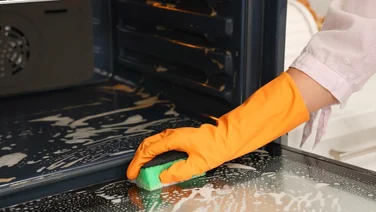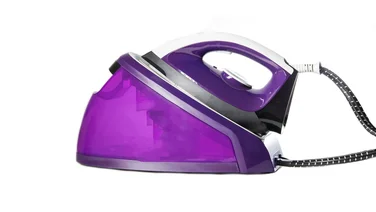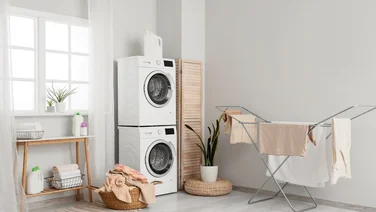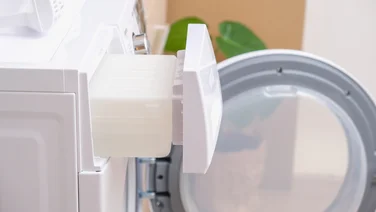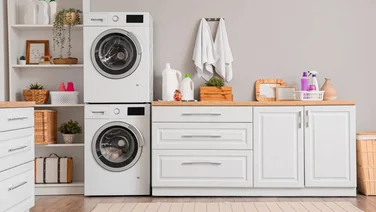To help us provide you with free impartial advice, we may earn a commission if you buy through links on our site. Learn more

The first thing that I noticed about the Miele W1 WMB120 washing machine was how sturdy and heavy it is. Compared to other 8kg machines, the WMB120 is a bit of a lump and it certainly weighs a lot more, too. Far from that being a bad thing, it shows just how ruggedly constructed this washing machine is. Besides, extra weight should mean it stays put even when spinning at full speed, and this was certainly one of the less intrusive washing machines that I’ve tested. There’s a lot to be said for build quality and it’s fair to say that the WMB120 is one of the best made machines that I have seen.
Miele has also decided to keep things simple with its front panel, with a simple dial switch that lets you pick the type of wash you want (Woolens, Delicates, Cottons and so on). Once you’ve set your wash type, you can then use the additional option buttons to customise it to your esact needs. These include adjusting the temperature and spin speed, plus you can say how soiled your garments are (Light, Normal or Heavy) to further tailor the wash and get your clothes as clean as possible.

On top of those options, the W1 WMB120 has a set of wash options to improve the quality of your wash. There are the usual options for a short cycle, an extra rinse (this is good for allergy sufferers that need all of the detergent washed out), and soak and pre-wash options for getting heavily soiled garments cleaner. For this machine, there’s also the Pre-ironing option, which uses steam, via the SoftSteam honeycomb drum, to smooth out garments after they’ve been cleaned. It makes a noticeable difference and makes garments that bit easier to deal with.

Capacity
As noted, the W1 WMB120 has an 8kg capacity. This isn’t the largest load capacity that I’ve seen, but it’s probably the most practical for the majority of households: this gives you enough space for a regular week’s washing and there’s room for bigger items, such as duvets, too. Besides, washing machines work out to be more efficient the closer you have them to full capacity, so 8kg is easier for most people to deal with than larger 10kg machines.
Water and electricity usage
To test how efficient washing machines are, I use the same 3kg load of washing on each machine. This gives us an even playing field for comparisons, regardless of drum size, and lets me see the effect that various settings have, such as increasing the temperature.
For this machine I started with a 30C Cotton wash, which used 30L water and use 0.43kW of power, giving a reasonable running cost of 15p per cycle. Upping to 40C, power consumption jumped a little to 0.62kW, although water usage was still very good at 32.5L. This gave me a running cost for this cycle of 19p, which is still competitive, although I have seen machines a few pence cheaper to run. If you’ve got lightly soiled garments, there’s a 20C wash mode, which used just 21.9L of water and only 0.35kW of power, giving a running cost of just 11p per cycle.
As these tests don’t fill the machine to capacity, I also used information from the EU energy label. Using these figures, I can work out average yearly running costs. The full information is in my how we test washing machines article, but the figures use the UK average wash size, taking into account full loads. In other words, an 8kg machine would require fewer cycles to clean the same amount of clothes as a 6kg machine.
Using these tests, I got running costs of £25.42 for low-use, £38.14 for medium use and £50.85 for high-use families. There are some cheaper machines, by a few pounds, but this A+++ rated washing machine still performs well.
Wash performance
While running costs are certainly important, it’s a washing machine’s ability to actually clean clothes and remove stains that’s really important. To test this, I use specially formulated stain strips, impregnated with common laundry stains to see how well a machine actually cleans. At 30C and 40C, I found very similar performance, with even stain removal across the board. Dropping down to 20C, the blood removal was very good, although slightly more of the red wine stain was left. Again, stain removal was very even, with no creases or patches of concentrated stain left. The clothes came out relatively dry, too, thanks to the high 1,600rpm spin speed. On average, my set of clothes retained almost 900g of water, which is impressively low.
I washed clothes using standard detergent, but the WMB120 also supports Miele’s CapDosing system. You simply fit the capsules of specially formulated detergents, fabric conditioners and additives, such as for wool care, into the drawer and then clip the lid down. It’s a neat system and could prove useful if you’ve got a lot of garments that need special care.

Conclusion
You can get cheaper washing machines and there are some that are a little more efficient, but getting efficiency and amazing build quality is hard, and the WMB120 is exceptionally well built. Throw in the excellent 10-year warranty and incredibly simple controls, and this washing machine is the ideal choice for anyone that wants a solid and reliable machine with excellent cleaning results.


